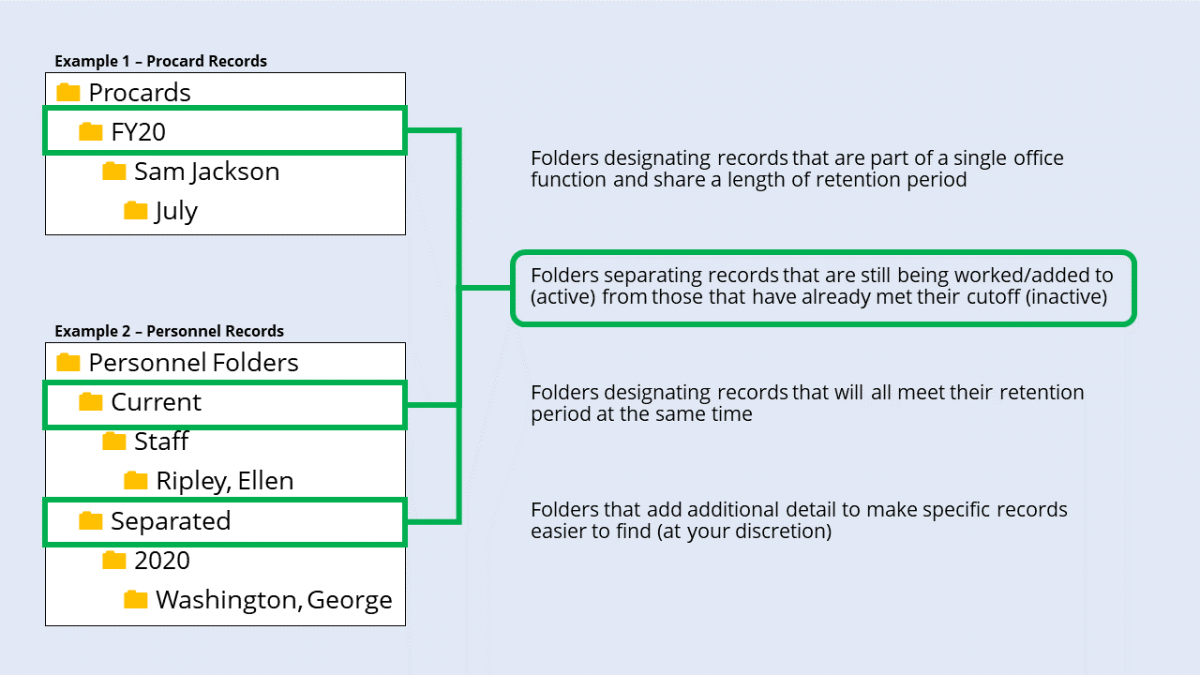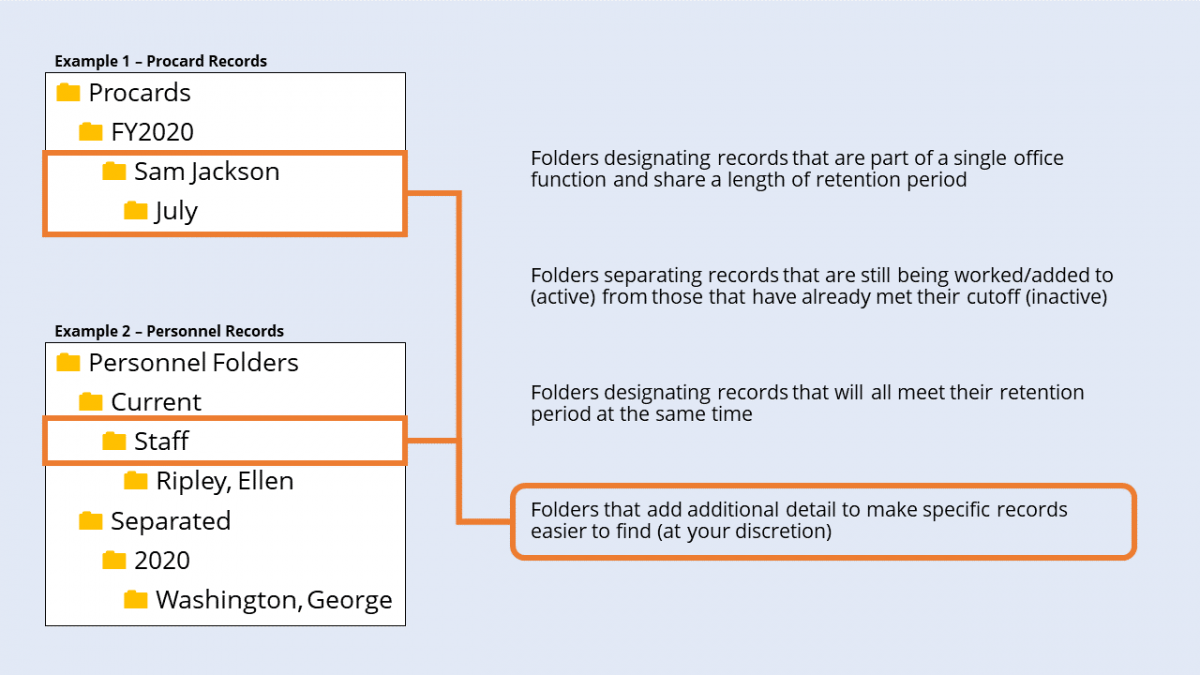As a state agency, the University of Washington has a legal responsibility to demonstrate the proper care and management of its records. In addition to adhering to an approved retention schedule, this also means organizing your records in such a way that they can be located, viewed, and disposed of in a straightforward manner. While the focus has changed from paper to electronic records, the organizational concepts remain much the same across formats.
A well-designed filing system will:
- offer quick and easy storage and retrieval of information;
- ensure integrity and continuity of recordkeeping practices despite personnel changes;
- align with the retention periods of the records it contains;
- be expandable and flexible enough to meet users’ needs.
This guide provides recommendations and best practices for designing a system to organize your office’s electronic records.
The Benefits of Good Organization
- Reduces the number of documents you keep
- Less time spent filing, searching for, and cleaning up information
- Fewer lost documents
- Improved onboarding and offboarding of personnel
- Improved regulatory compliance
- Stronger business continuity in the event of a disaster or an unplanned emergency event
- Reduces the risk of penalties for delayed or incomplete response to audits, lawsuits, and public records requests
Critically, while it can be difficult to quantify, a good filing system spares individuals time and energy spent performing after-the-fact records management. The right filing system produces important tangible results and eliminates costs associated with poor procedures.
Steps to Developing a New File Plan
- Involve Your Stakeholders
-
When planning changes to any system, it is important to inform and involve the right people from the beginning. If you are working on your personal storage space or email, you may not need to involve anyone else. However, if you are planning to make changes to a shared space, it is best practice to:

Form a small workgroup led by a Records Coordinator (i.e. someone with knowledge of and responsibility for the office’s records). Having an informed understanding of the records management requirements of your office’s records is key to designing a successful filing system.

Obtain executive support of the office Records Authority (e.g. Administrator, Director, Chair, etc.). Administrative support legitimizes the project and ensures the cooperation of all members of the office.

Seek the input of representatives from each functional area in the office. The creator of a record may provide important insight useful during the inventory and analysis of the records. Office members can help determine which aspects of the present system work well and should be retained, as well as help identify specific problems within the present system that should be changed.
In addition, ensure every member of the office understands the purpose and scope of the project. Involving others in the process results in a better system and increases compliance once it is implemented.
- Accounting of Existing Records
-
Inventory
The first step to developing a new or making changes to an existing filing system is conducting an inventory. An inventory is a detailed listing of all existing documents and files in an office. The purpose of the inventory is to provide you an understanding of WHAT records are being created to make sure all of your electronic records deserve and have an appropriate home in the new filing system. The inventory also helps to identify inconsistencies in how information is currently being stored, accessed, and managed.
In an average office or department, information resides in many places. It is very likely you are dealing with one or more shared drives as well as individual drives; your employees may be working in OneDrive, Google Shared Drive, or in SharePoint/Teams; you may have a departmental email account; and we know everyone has one (or more!) email accounts containing University records. Keep your inventory simple. Focus on one location in which files reside at a time.
At this stage, the goal is to create a spreadsheet of all of the files contained in the chosen location. At a minimum the inventory should include the file name and folder/path, though additional metadata such as creation date, date last modified, and author can helpful if you are able to obtain it. You will be manipulating and adding information to this spreadsheet as you perform your analysis. If you need help creating your inventory, contact your local IT administrator or UW-IT; Records Management Services may also be able to assist you.
Analysis
Now that you have an understanding of WHAT records are being created, it is time to ask WHY they are created and HOW they are used. Performing this analysis and answering these questions helps you decide where to store records and the amount of organization to apply in each case. This is the hardest and most time-consuming part of improving or creating a new filing system.
Search your inventory for files that relate to a particular subject or function, result from the same activity, or belong to a particular case or project. These are the categories of files you want to pull together so they will be easier to find and manage moving forward. They will be the basis of your new filing structure. In filing systems that need an overhaul, these files will be in multiple folders with varying folder titles, or they will be so poorly labeled they can only be identified by opening and reading them.
To help you start batching like with like, consider the following:
- Who in the office creates these records?
- Who in the office uses these records?
- How often and for how long are they accessed?
- Given the age and the content, are some of these records ROT (redundant, obsolete, and/or transitory)? Make special note of these records so they can be deleted before being moved into the new system.
- What information will I have access to when searching for a particular record?
- What is the volume of records created in a month/quarter/year?
- Will this influence my folder structure?
- What are the security, privacy, or confidentiality concerns around these records?
- What is the required retention period for these records?
- Are these Vital Records?
You may want to create additional columns in your inventory to record some of this information. For example, offices with teams can add a column which allows you to filter and sort by records belonging to each team. If your office does not have teams, instead categorize files by function such as HR, Finance, Faculty, Grant Management, Student, etc. Within the team or function, we highly recommend creating a column to identify records by type. You could also add an additional column and identify the proper retention period for the records or identify records as transitory. Sorting and filtering based on these newly entered columns will help you identify patterns and commonality among records. This will inform a folder structure that becomes the basis for your new filing system.
Example file inventory File Name Path Team or Function Type of Record Retention Period 2025 Procedures for the SRC report.docx \recmgt\_SRC Rpt SRC Team Procedures Obsolete + 0 yr For Marking Indexes.txt \recmgt\_SRC Rpt SRC Team Procedures Obsolete + 0 yr Template UW Summary of Changes.docx \recmgt\_SRC Rpt SRC Team Procedures Obsolete + 0 yr replicated DAN Student Petitions analysis.xlsx \recmgt\_SRC Rpt SRC Team Working Doc Transitory RG number changes list.xlsx \recmgt\_SRC Rpt SRC Team List/Log Transitory Feb2025_DataDump_and_Controls.xlsx \recmgt\_SRC Rpt\2025\Feb SRC Team Working doc Transitory README re changes from Russell.txt \recmgt\_SRC Rpt\2025\Feb SRC Team Report Submission + 6 yr State_Report_Feb2025.accdb \recmgt\_SRC Rpt\2025\Feb SRC Team Working Doc Transitory UW Retention Schedule v.2.11 (Feb 2025).DOCX \recmgt\_SRC Rpt\2025\Feb SRC Team Report Submission + 6 yr uw-summary-of-changes-v.2.11-(feb-2025).pdf \recmgt\_SRC Rpt\2025\Feb SRC Team Report Submission + 6 yr A word about ROT...
One major goal of your new filing system should be to reduce ROT. ROT stands for Redundant (duplicate copies/earlier drafts of finalized documents), Out-of-Date (documents past their retention period), Transitory (documents that did not need to be filed or saved). Use your inventory to identify ROT and delete it before developing a new or improving an old filing system. Make sure your future state avoids creating places for new ROT to accumulate. Consider calling out spaces specifically for transitory records like working documents, drafts, and reference materials that can be cleaned out and deleted on a regular basis. Be thoughtful in file and folder titles; make it easy to recognize records that are ready to be deleted.

- Develop a New Filing System
-
Once you have a sense of all of the records you possess and the business needs surrounding them, you can begin to design the future state. This is where the time and effort spent on your records inventory and your analysis pay dividends. Often the simplest approach is best; minimizing the number of folders to only what is needed and ensuring they are labeled in a clear and consistent way results in a filing system that is more efficient and easier for people to use. The most efficient and economical filing system is one that works well for the office and is easily understood by its users.
Decide on location
Decide which repositories you are going to use and what types of records will reside there. Begin by making some decisions about where your records will live going forward (e.g. network shared drive, OneDrive for Business, SharePoint, database, etc.). Consider your requirements for access, privacy/security, and lifecycle management. Records that have privacy/security requirements and are used only by one or a few employees should be assigned space with restricted permissions. For files that are used by most or all of the employees in an office, while it is not necessary to put all of your records on a single storage platform, consolidating by function or purpose will make managing your records easier. Also note that repositories provide different degrees of privacy/security that may not be appropriate for all types of records. For example, while Slack is wonderful for transitory communication and project development, it is not appropriate for use with University records containing personal or confidential information including any credit cards, student/academic, research, or HIPAA-protected records.

For help deciding on where to store your office’s electronic records, please consult our resource on Choosing the Right Electronic Storage Location as well as this enterprise file service comparison provided by UW-IT and contact our office at recmgt@uw.edu with any questions you have.
Building a resilient folder structure
After settling on a storage location, the next step is to create a “sandbox” outside of your current filing system and build the filing structures that best allow you find and manage the records. Within each repository files should be arranged in an order best suited for rapid retrieval and disposition. Use a feature or characteristic of the record as the basis for the arrangement. Features may include a subject, a function, or literally describe the type of records in the folder.
Ask yourself:
- How will someone look for this information?
- How will someone know when to delete these files?
- Think about criteria you would use when performing a search
- Be sure to eliminate redundancy
- Be sure to eliminate ambiguity
A good folder structure has two primary components:
- A function-based aspect that groups together records created or used as part of a single office function.
- A time-based aspect that identifies records that will collectively reach the end of their retention period and useful lifecycle at the same time.
Focusing on these two aspects results in folders that are each covered by a single retention period and can be deleted once that period is up, without having to review the individual records/subfolders they contain. That includes separating out transitory records, such as drafts and working documents, which have shorter retention periods, and can be deleted upon completion of the final product.

Additional controls
In addition to the two primary requirements for categorizing records above, you should add subfolders as needed to organize your work in a way that makes sense given your office’s workflows. Consider file naming conventions to boost recognition and manage version control. The important thing to remember is that no amount of organization is worth anything unless the system helps users and is easy to work in. Avoid the temptation of building in unnecessary complexity.
Below are examples of sound folder structures for records commonly found throughout the University. Legitimate alternatives will vary in detail and complexity but remain valid so long as they accomplish the principles outlined above.




For help designing appropriate folder structures to organize your office’s electronic records, please refer to our resource on Best Practices for Folder Structures and contact our office at recmgt@uw.edu to set up a consultation. Once deciding on your storage location and organizational scheme, combine these elements and build your own custom policy using our E-Record Policy Builder.
- Inform Users, Receive Additional Input and Feedback, Provide Training
-
Now that you have a well-considered future state “sandbox” to present, it is time to bring all users up to speed so that they do not see the changes appear without understanding what is expected of them. You have already been communicating with and involving key stakeholders along the way; now will be everyone’s first opportunity to see the new solution built out and ready for implementation.
Before presenting:
- Make sure you have developed the system thoroughly to minimize the potential for unanticipated “what about [blank]?” questions.
- Be explicit and document your new draft filing system.
- Work out any perceivable flaws so that the new system has credibility.
- Allow presenters and sponsors time to become familiar with the new system to avoid any disagreements or conflicting understanding at the training/rollout.
 Training presentations should:
Training presentations should:- Present the goals of the new system and explain the specific reasoning behind some of the major changes.
- Sell the upside and stress the importance of everyone adhering to the new structure.
- Spell out any changes to existing procedures. What are you requesting staff do differently?
- Offer users the opportunity to ask questions or make constructive suggestions.
- Assign responsibility: Who should people ask about changes to the structure? Who is responsible for cleaning which folders?
- Discuss the plan for implementation and timetable. Is there a period in which you will be living in both systems?
- Explain that this is a continuous improvement project; feedback is encouraged and adjustments will continue to be made to improve the system as workflows and processes evolve.
In addition to training existing staff, document all decisions in such a way that it can be provided as training to new employees and serve as a reference for future changes to the filing system.
While creating this level of in-depth indexing is not required, the following is an excellent example of filing system documentation:
Folder Name: Lab Exam Test Results
Contents: Provides a record of preventative or responsive health hazard evaluations in the workplace. Includes raw data, quality control, standards, and calibration information for environmental and biological samples related to compensation, claims, and investigation of industrial hygiene and health problems in Washington covered industries. Maintained as per 29 CFR1910.1020.
Access Restrictions: Read/write access limited to lab managers and their supervisors.
Folder structure: Each evaluation and related documents should be stored in its own subfolder named after the 10-digit evaluation number beginning with the two digit year.
Retention: Annually, the custodian will review the contents of the Lab Exam Test Results folder and delete any subfolders that are past retention and not on legal hold. Current retention requirements can be found here: http://finance.uw.edu/recmgt/gs
Custodian: Walter White <wwhite@uw.edu>
Records Management Services staff are available to assist in preparing and/or presenting training materials.
- Implement system
-
At this point, you have already gathered user input, outstanding questions have been addressed, the future state is agreed upon, and now it is finally time to start making changes that users will be able to see. Be sure to refer back to the work you did in your records inventory and analysis.
Purge ROT
Prior to moving any records into the new system, you will achieve your biggest reduction in volume and clutter by deleting your existing ROT. ROT includes records that are past retention as well as drafts, unnecessary duplicates and transitory records that no longer hold any business value.
Before you delete anything:
- Some records may be on destruction hold due to ongoing or pending audits, lawsuits (or even reasonably anticipated lawsuits), or public disclosure proceedings. Records on destruction hold must not be destroyed, damaged, or altered until the issue is resolved and you are specifically advised that such records may be destroyed.
- Some substantive records have long-term historical value and are designated as archival on the General Records Retention Schedule. Rather than be deleted or retained indefinitely within your department, these records should be transferred to University Archives for permanent retention.
Migrate records with continuing retention
After purging the ROT, it is time to migrate the remaining valuable records into your new folder structure. Use your inventory to identify which documents will be filed together and move them into their new repositories, directories and folders. Depending on your situation, you may want to roll out the new structure all at once or it may make more sense to use a staged approach by implementing the new structure one function at a time. This decision will depend on your timetable, the size of your group, the volume of records, and the priority you assign for moving records to the new system. This is the point where your “sandbox” transitions to become the new filing system and the old system should become inactive.
If you do implement a staged rollout, be sure the roadmap and timing are well communicated and understood by those who will be impacted. It is important that users not continue to save new records to the old locations after the changeover has occurred.
Create a temporary home for what's left
 Often during a records clean-up, there will be a small minority of folders that contain:
Often during a records clean-up, there will be a small minority of folders that contain:- A. transitory or obsolete records that some of your staff, for political or cultural reasons, will be extremely reluctant to have deleted, or
- B. low-value records, typically created people who are no longer with the department, that would be exceedingly time-consuming to review thoroughly.
Rather than allow these roadblocks to bog down your project:
- Move these folders into a single directory called “pending deletion” located outside of your new folder structure.
- Mark the folders as read-only so that records cannot be added or modified in this location.
- The value of these records will be evaluated by future use. If a need for records from this location arises, the files in question will be moved out of this directory into the appropriate folder in the new filing system.
- After a safe but sensible period has passed, delete the folder and any remaining files:
- For folders containing transitory and obsolete records, delete one year after implementation of the new filing system.
- For folders containing un-reviewed records, apply the longest applicable retention period from the date of the latest document (for most offices, not longer than 6 years) – make note of that date for each separate folder.
This gives staff an opportunity to retrieve important records and creates additional justification for deleting records that were not used during this “grace period.”
- Document these decisions and scheduled destruction dates within the folders such that future users will be able to follow through on deletion with confidence that further review and retention is not needed. Include the names and titles of the approvers/decision makers to add authority.
Note, this approach is intended to only be used as a last resort and should be applied sparingly and thoughtfully. If you are confused or uncertain about what you need to keep or for how long, please contact Records Management Services with questions.
- Monitor Implementation, Follow Up, and Revise System
-
It is unlikely that any new folder structure will be perfect out of the box. Schedule time a few weeks out to check in with users to see what is working and what needs additional attention. If some folders receive only infrequent use, schedule additional check-ins further out to provide staff time to form opinions. Make your adjustments thoughtful and consistent.
 As your office continues to change and grow, so will your filing system. Processes and workflows evolve over time causing existing folders to become inadequate or obsolete. Actively take steps to prevent the accumulation of ROT and clutter. Periodically check to ensure the filing system continues to meet the needs of the office and users. Confirm that users are following the existing structure and that records are not being misfiled. Incorporate these system checks as part of your annual clean-up days.
As your office continues to change and grow, so will your filing system. Processes and workflows evolve over time causing existing folders to become inadequate or obsolete. Actively take steps to prevent the accumulation of ROT and clutter. Periodically check to ensure the filing system continues to meet the needs of the office and users. Confirm that users are following the existing structure and that records are not being misfiled. Incorporate these system checks as part of your annual clean-up days.As you make decisions and changes regarding your new filing system, update your written documentation to ensure success and compliance. If the length or breadth of your office’s policy precludes its use as a quick reference, consider creating something less detailed to serve as instructions for users. The goal is to provide both an up-to-date resource for new employees and to serve as a reminder for existing staff.
- Carry Out Annual Purge
-
Just having a strong organizational structure is not enough. Even the best files management efforts cannot prevent the eventual buildup of records from becoming overwhelming. The only solution that works over the long term is continually applying retention to all of the records. Everyone should be empowered to delete redundant, obsolete, and transitory records as they pass retention. Establish a systematic process for more substantive records in order to ensure compliant and defensible destruction.
At least annually, place one or more staff in charge of identifying folders containing records that are past retention.
Make certain everyone involved understands what the retention requirements are and/or how to look them up on either the General Records Retention Schedule or your Departmental Records Retention Schedule (if applicable). Have your Records Authority (i.e. your Administrator, Director, Chair, etc.) review the resulting list of folders looking for mistakes or records that should be on legal hold before they provide the approval to delete. Upon approval, staff should contact University Archives to transfer any archival records and delete anything non-archival. If your office maintains a destruction log, make certain you update it for the period in question. Your annual purge should include folders in the “pending deletion” location, should you have one.
Have your Records Authority (i.e. your Administrator, Director, Chair, etc.) review the resulting list of folders looking for mistakes or records that should be on legal hold before they provide the approval to delete. Upon approval, staff should contact University Archives to transfer any archival records and delete anything non-archival. If your office maintains a destruction log, make certain you update it for the period in question. Your annual purge should include folders in the “pending deletion” location, should you have one.Remember to contact Records Management Services when planning your clean-up day. Our office can:
- Help you plan the event beforehand.
- Be present (physically or virtually) to answer any questions that come up in real time and help keep the clean-up day forward momentum going.
- Help you measure what you have accomplished once the clean-up is finished.
Email us at recmgt@uw.edu to get started.
- Additional Resources
-
If, at any point in this process, you have questions or uncertainty threatens to delay your progress, contact Records Management Services at recmgt@uw.edu. Our staff can meet with you to go over these issues and help you move forward with confidence.